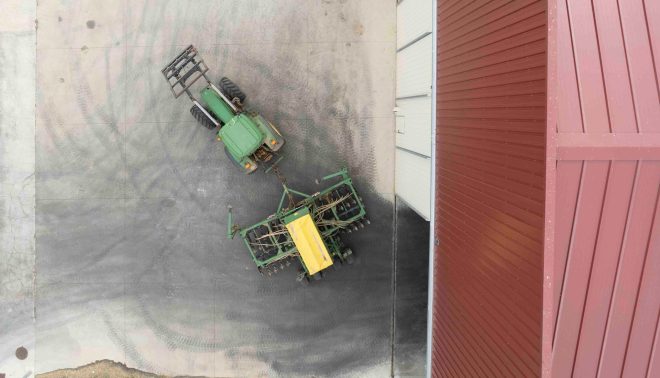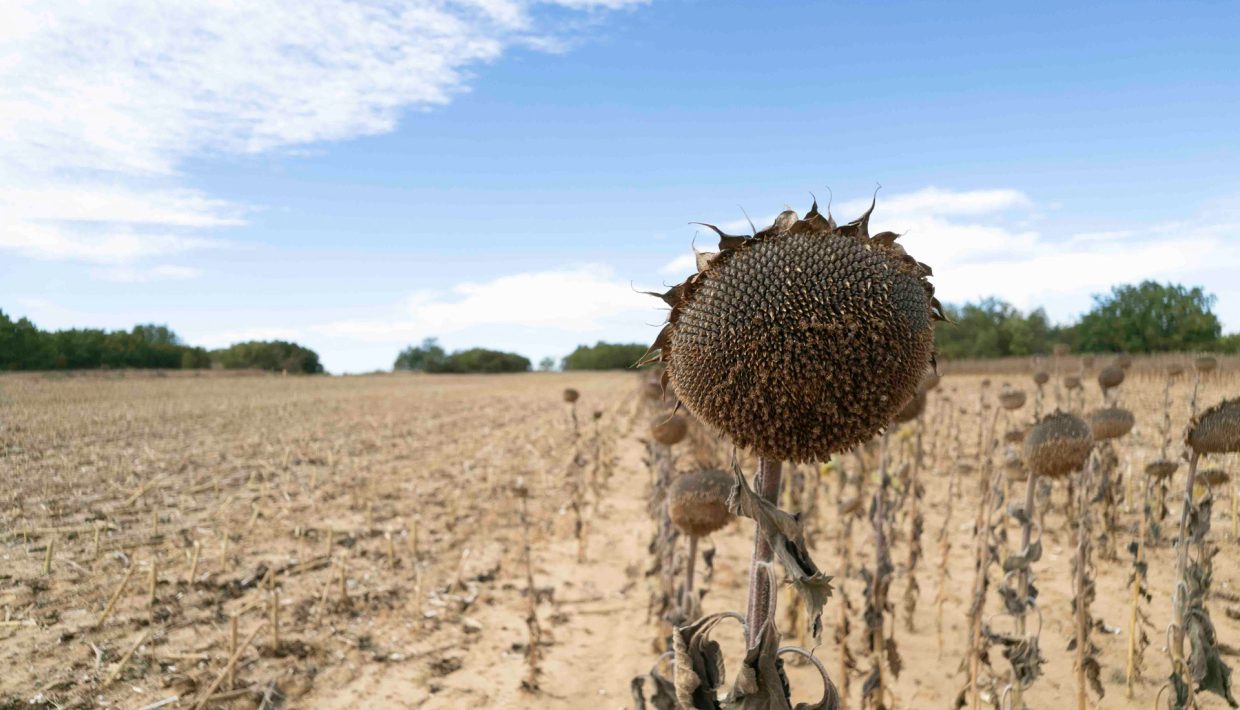We came to the province of Palencia, in northern Spain, in the region of the municipality of Osorno La Mayor, where we were greeted by Jorge Prieto, a fourth-generation family farmer. Here, crops are grown at an altitude of 800 to 920m above sea level. Irrigated agriculture is constantly expanding, but most of the fields are still dedicated to extensive crop raising without irrigation – such as wheat, barley, sunflower, oats, triticale, vetch, and rapeseed.
Since last spring, the situation has completely changed.
Jorge Prieto
It’s sunflower harvest season. This year, this harvest will take more time than usual, because of the war in Ukraine, which has led to an increase in the area sown with this crop. The events of last spring have required a modification in plans for this season. One of these changes involved an increase in sunflower cultivation. As is the case in other regions of Spain, with the green light from the government, some of the fields, which were planned to remain fallow, have been planted with sunflower. Thus, the farmers hope to increase their income, because this year, the sunflower fields will yield more.
Advice
They have long been able to count on the advice of Víctor Sánchez-Girón, professor at the Polytechnic University of Madrid and a recognised expert in the field of mechanised agricultural production. With his help, this family of farmers began to experiment and implement changes in their agricultural work. These improvements have proved their usefulness in increasing the profitability of the operation, and have also served to facilitate adaptation to the current circumstances.
A fundamental aspect of these two elements is that the machines are adapted to the needs of the farm, as well as the use of equipment being adapted to each tractor, explain Jorge and Víctor.
To use a very powerful tractor with undersize equipment, means wasting the investment made for the tractor.
Víctor Sánchez-Girón
In order to save on fuel, it is essential that the combinations of tractor and equipment are correctly implemented. Both men agree: “To use a very powerful tractor with undersize equipment, means wasting the investment made in the tractor.And using a small tractor with oversize equipment, makes the tractor run at full speed, thus consuming too much fuel.”

They also try to optimise their expenditure on tyres, as well as fuel, by adjusting tyre pressure according to the working conditions. “We lower the pressure to 1.5 bar for work in the fields. While for driving on the road, we increase it to 2.5 bar,” explains Jorge.
Soil Work
For some crops, the farmers have been using direct seeding for over 30 years, but currently, they are mostly doing minimal tillage, using special equipment that combines cultivator, cage-type roller, and harrow. This allows them to achieve significant savings in diesel fuel use, because it only requires one pass to have the soil ready for seeding. The operations for minimal tillage and direct seeding are a little less numerous than those requiring conventional tillage, but profitability is better, because the farmer achieves lower overall costs. And, together with crop rotations, the difference in productivity, compared to conventional tillage, is even smaller.

Another important aspect of soil preparation is to till it at just the right time – a method that also saves on fuel costs. Jorge explains: “Before, we didn’t pay much attention to the condition of the soil, so the tractor engine often ran at 1800-1900rpm.Now we work the soil when its moisture content is most suitable, and so we manage to maintain a speed of 1300-1400rpm on the engine, with the corresponding fuel savings that this brings.”
Sowing
FFor seeding, one measure they have adopted is to reduce the rate. “We used to sow 250kg per hectare for crops such as barley and wheat, but for the past few seasons we decided to reduce this figure to 210kg/seed/ha, and we have found that this was to our advantage.”
Modern machines are of enormous help, but to get the most out of them, they need to be set up perfectly.
Jorge Prieto
The use of seed drills for direct seeding also contributes to a reduction in fuel requirement. “Modern machines are of enormous help, but to get the most out of them, they need to be set up correctly. Regardless of the type of seeder used, it is essential that the machine is well maintained and calibrated, so that the seeding is correctly performed,” add Jorge and Víctor.

Fertilizer Spreading
Previously, it was normal to apply fertiliser twice during the crop cycle. One application was made before seeding and another when the crop had started to develop. Now, they use a slow-release fertiliser in one operation, and a spreader with section cut-off, which spreads the fertiliser more efficiently. The fertiliser is spread in a single pass with a centrifugal spreader. The fertiliser itself is complex and contains an ammoniacal stabiliser, which releases its nitrogen content little by little, leaving a small amount immediately available to the plant.

With the war, the fertiliser prices tripled. So, the farmers decided to reduce the dose. Whereas, they used to spread 500kg/ha, this figure is now 350kg/ha. They also use cheaper and less concentrated fertilisers. Instead of 12-24-16, they now use 8-15-8. This helps them to reduce fertiliser costs.
Now we sow a lot of legumes, because these don’t need fertilizer.
Jorge Prieto
And there are crops where they do not use fertiliser, for example vetch, which is a legume that they have sown more of this year. “Now we sow a lot of legumes because these don’t need fertiliser. Another form of fertiliser saving – is to include more vetch in the crop rotation,” says Jorge.
Introducing a crop of legumes, in rotation with cereals, helps maintain soil fertility, as legumes fix between 70 and 80% of the nitrogen they consume from the atmosphere thanks to bacteria that live, in symbiosis, in their root nodules.
Traditionally, the main crops in their rotations were wheat, oats, triticale and vetch. This year they have increased the cultivation of vetch and sunflower, at the expense of the others, and they are also considering including rapeseed in their crop rotation, as it adapts well to the region’s soils.
Crop Protection
“Our biggest problem is weeds,” says Jorge. “And the total cost, of the herbicides that we use, has doubled. To alleviate the problem, this year we are significantly adjusting the dose.” They went from applying three litres/ha to 2.5 litre in most fields. They apply the maximum dose only occasionally.
This year, we are adjusting herbicide doses much more.
Jorge Prieto
And to save even more herbicide, they plan to use reverse rotation tilling and change the rotations, increasing the share of less weedy crops, such as sunflower.
Harvests
During harvest,the main objective is to increase efficiency, in terms of machine use, labour hours and fuel,explains Víctor. So they have invested in more powerful combines with larger hoppers, and trailers that can accommodate larger volumes. “All this allows us to reduce harvesting costs per kilo harvested,” notes Víctor.

Diversification
Another way to improve the farm’s profitability, is to diversify, in order to generate other sources of income. For several years now, they have been offering their services to other farmers in the region, mainly in the poplar plantations. This region of the province of Palencia is home to many poplar fields, on the riverbanks.
“Working in woody crops, such as poplar groves, allows us to generate income all year round,” says Jorge. To keep the plantations free from weeds, they go between the trees with 30 or 26 inch (75 or 65cm) disc harrows, taking advantage of the machines they already have.
When asked if there is a future in agriculture, their answer is clear: “Of course there is. The key is to optimise, improve and become more efficient.”




